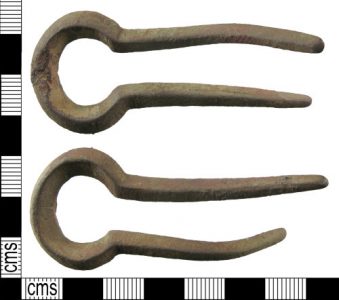JEWS HARP 779676
Description: A bent and incomplete post-medieval (c.1500-1800) copper alloy Jew's harp (also known as a Jaw's harp), missing its iron tongue. It is lozenge-shaped in cross-section, measuring 70.6mm in length, 29.9mm in maximum width and 8.8mm in maximum thickness. It weighs 24.45g. The mouth end is circular in shape (internal diameter c.15.9mm), with the arms of the object extending straight downwards and tapering to two blunt points. One arm is bent upwards transversely roughly half way along. There is a rectangular notch on one edge of the outer curve for the missing tongue, retaining a small amount of iron corrosion.
The Jew's harp, or trump, is an ancient folk instrument with a wide geographical distribution. It is indigenous to South-east Asia, and was certainly introduced to Europe by the time of the Crusades. The European Jew's harp, familiar today, is made of metal, usually iron, and the tongue is a separate component hammered into a rabbet in the thickest part of the frame. At its other end the tongue is bent into a prong, but this rarely survives in archaeological contexts. In play, the instrument is held in one hand and the frame is lightly supported between the player's teeth, while the metal tongue is plucked with the fingers on the other hand. The mouth cavity acts as a resonator and the pitch is modified by the position of the lips, tongue and cheeks (Egan, G. 1998."The Medieval Household Daily Living c. 1150 - c. 1450", p.284). Jew's harps were current from the medieval period right up until the 18th century (and are still used in specialist folk music circles today), but medieval examples are rare.
Date: 1500 - 1800
Object type: JEWS HARP
Last import: August 15, 2017


